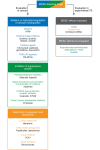Therapies for tuberculosis and AIDS: myeloid-derived suppressor cells in focus
- PMID: 32420917
- PMCID: PMC7260010
- DOI: 10.1172/JCI136288
Therapies for tuberculosis and AIDS: myeloid-derived suppressor cells in focus
Abstract
The critical role of suppressive myeloid cells in immune regulation has come to the forefront in cancer research, with myeloid-derived suppressor cells (MDSCs) as a main oncology immunotherapeutic target. Recent improvement and standardization of criteria classifying tumor-induced MDSCs have led to unified descriptions and also promoted MDSC research in tuberculosis (TB) and AIDS. Despite convincing evidence on the induction of MDSCs by pathogen-derived molecules and inflammatory mediators in TB and AIDS, very little attention has been given to their therapeutic modulation or roles in vaccination in these diseases. Clinical manifestations in TB are consequences of complex host-pathogen interactions and are substantially affected by HIV infection. Here we summarize the current understanding and knowledge gaps regarding the role of MDSCs in HIV and Mycobacterium tuberculosis (co)infections. We discuss key scientific priorities to enable application of this knowledge to the development of novel strategies to improve vaccine efficacy and/or implementation of enhanced treatment approaches. Building on recent findings and potential for cross-fertilization between oncology and infection biology, we highlight current challenges and untapped opportunities for translating new advances in MDSC research into clinical applications for TB and AIDS.
Conflict of interest statement
Figures


References
-
- Young MR, Wright MA, Lozano Y, Matthews JP, Benefield J, Prechel MM. Mechanisms of immune suppression in patients with head and neck cancer: influence on the immune infiltrate of the cancer. Int J Cancer. 1996;67(3):333–338. doi: 10.1002/(SICI)1097-0215(19960729)67:3<333::AID-IJC5>3.0.CO;2-S. - DOI - PubMed

